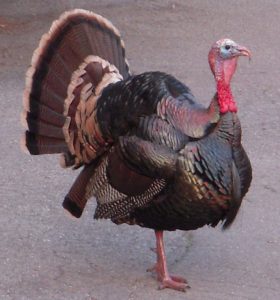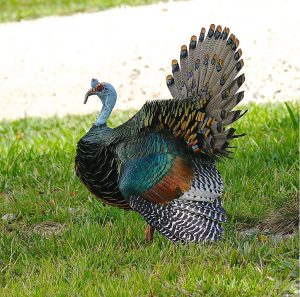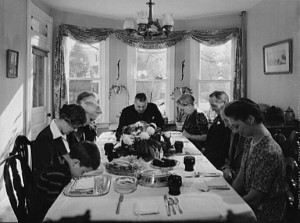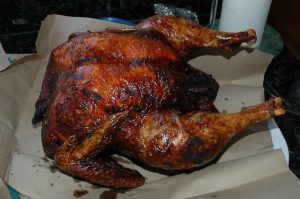Here are some fun and interesting facts about the turkey and Thanksgiving.
Turkey is native to North America and has two breeds:
Wild Turkey (Meleagris gallopavo)
This is found in eastern and central North America and Mexico.
Ocellated Turkey (Meleagris ocellata)
Found in the Yucatan Peninsula and Central America.

Image credit: Feezo
Image via Wikimedia Commons
Turkeys were domesticated by native peoples. The Spanish brought back turkeys to Spain and from there they gradually made their way into the cuisine of Europe. English explorers and settlers would bring back turkey to England where they were apparently domesticated since records indicate they were being eaten by the British in the 16th century.

Image credit: TonyCastro
Image via Wikimedia Commons
Due to its abundance in North America, Mexico, and Central America, the turkey was not seen as something special due to its availability. This is probably the reason why it was not mentioned as a meat served at the first Thanksgiving though it was likely served.
Beef and pork were seen as holiday meats and were generally only eaten on important days like Christmas, Easter, or other special events. The Irish, for example, preferred pork for St. Patrick’s Day since it was easier than cattle since they take up lots of space while pigs could be kept in a pen. This only changed when Irish came to America and found beef in easy abundance and luckily for them delicatessens had corned beef.
By the 18th and 19th centuries, turkey starts showing up more as a meat to be used when you did not want to slaughter a pig or a cow. Turkey also started becoming popular for feasts as well, though not at center stage just yet. In A Christmas Carol the kids were waiting excitedly for the goose to come back from the baker showing its importance for Christmas feasting. Turkey starts showing up more in books and illustrations as a Christmas food. In 18th and 19th century America lobster was seen as a poor man’s food since people of wealth could afford beef, pork, goose, or turkey.
During the latter part of the Victorian Era (1837-1901), turkey would replace beef and pork for Christmas. As upper-class people and Queen Victoria embraced it, others followed suit and it would replace the goose for Christmas. In the United States, turkey became associated with Thanksgiving due to both images and stories of it being eaten at the first Thanksgiving. As stated earlier, there is no mention of turkeys at that meal, but it is more than likely they were served. As the image of turkeys being part of that Thanksgiving seeped into the American consciousness, it eventually found its way to become part of the celebration itself. Turkey quickly displaced beef and pork (to the displeasure of their producers) as the central part of the feast. Today it is mostly unthinkable to not think of turkey as part of the Thanksgiving feast (with apologies to my vegetarian friends).
Today millions of turkeys are sold at Thanksgiving either frozen, fresh, or sometimes smoked. While the U.S. is a major consumer of the bird, more turkey is eaten in Israel than anywhere else. They really like turkey for their big feasts but of course it is served with Kosher accompaniments so you will not be having mashed potatoes made of milk and butter (since Kosher forbids the mixing of meat and dairy).
Despite their numbers being severely dropped for a while due to hunting and other things, the wild turkey is making a comeback and large flocks have been seen in the wild and sometimes in suburbs as well. Wild turkeys can fly short distances, but their domesticated cousins are flightless. The possible exception might be heritage turkeys raised outdoors and free to roam and eat.
Wild turkeys can be a bit of a nuisance though. They can get nasty, sometimes bite, and they leave some of their presence behind to be cleaned up. Sometimes it requires effort to chase them away though if a coyote or mountain lion should appear (and attack the flock) that generally gives them the hint to move on.

Photo: Public Domain (US Library of Congress, digital id#fsa.8d10749)
Roasting turkey in an oven is traditional but, in many areas, not always possible. In the early days, many homes did not have ovens as we know them. They might have open hearths or perhaps an area where they could heat up and put a turkey in. This led to bakers, who had ovens, often for a fee leasing out their ovens to cook a bird. Others would cook them in fat in large open containers in pits dug for this purpose. Others found ways to roast over an open fire by turning them often (a sometimes risky and tiring task since you had to stand close and manually turn it like today’s rotisserie sans electricity).

Image: Cygnus921
Filckr
Deep frying turkey may have started in the American South but went back further possibly to England, France and perhaps even to the Romans. Deep frying does cook faster and keeps it moist, but the key is the amount of oil used and how stable the platform to cook is. Some used deep pits, so this prevented fires or leakage. Above the ground requires the cooking platform to be kept clear of anything that might burn if there is a leak resulting in a fire.
The most common reason for mishaps with deep frying turkey is people do not pay attention to the amount of oil used to the weight of the bird. One hilarious video on YouTube had this guy lowering the turkey into the pot outdoors while saying he had followed the Archimedes rule of displacement. He miscalculated, hot oil spilled out of the pot and ignited with the open flame below, and then fully ignited. The other common reason is that people put a frozen bird into hot oil thinking there will be no problem. I am not sure if they didn’t pay attention in chemistry class or never heard why you do not put water into a hot pan with oil in it. The result in an explosion that can, if too close to the home (or foolishly enough inside it) means your home or apartment is going to be severely damaged. Or worse.
During World War II, the military tried to make sure troops everywhere had Thanksgiving even front-line troops. Those who served on military bases, ships, or in London probably had the best. For submarines the cook(s) had to contend with the unexpected action of the sub diving as they were cooking made Thanksgiving meal an adventure both in cooking and serving. And for those on the field with Germans in sight, getting those meals meant coming under direct enemy fire causing some commanders to question the wisdom of delivering meals while in an active fire zone.
And of course, Thanksgiving can be a source of humor as well. Just look at some vintage clips from shows past and present about it. The most classic one of course is the famous and never duplicated one from WKRP. As a promotion they decided to drop turkeys into a parking lot in front of a mall. And, well, you have to watch to find out.
